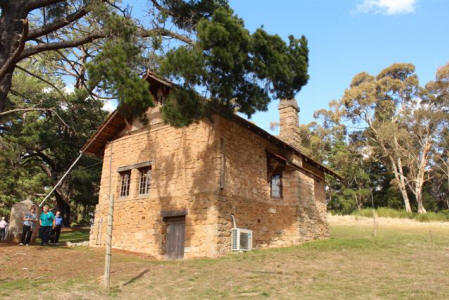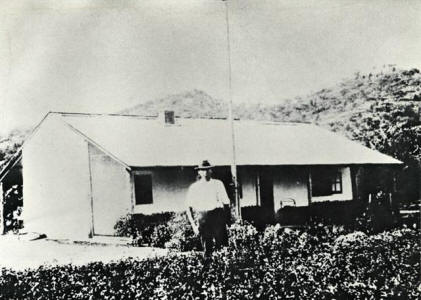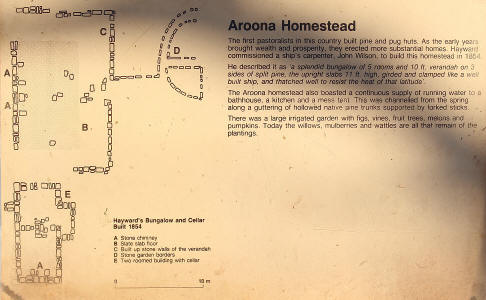Sir Hans Heysen's landscapes of
the Flinders Ranges, 'Droving into the Light', 'The Three Sisters of
Aroona', 'Hills of Arkaba', 'Ramparts of the Wilpenas' and 'Guardian of the
Gorge' are but a few of the renowned paintings the artist is famous for.
His first trip into the
Flinders Ranges was in 1926 catching a train to Quorn
where he stayed at the Transcontinental Hotel for a few days making sketches
of the surrounding area before continuing on to Hawker and the Royal Hotel.
From there he jumped onto the mail truck to Wilpena Station. Although
Wilpena made little impact on him, the country between the Pound & Hawker
certainly took his attention.
The following year Hans along with friend Joyner, headed
for Oraparinna Station where they were invited by the properties lessee, Mr
KP Sawer, to spend a few weeks at an outstation in the beautiful Aroona
Valley with Eddie Pumpa & his wife. The pug and pine hut was within walking
distance of some of the most scenic country the Flinders had to offer,
including Brachina Gorge.
From this base Hans produced many sketches and watercolours.
Eddie drove them to locations in his 1922 model Ford where he would drop the
two off, do his work and then come back to retrieve them.
In 1928 Hans was back to the Flinders roaming for a week or
two on station trucks beyond Blinman and in 1929 he stayed with Eddie Pumpa
once again, this time at the Wonoka Hotel as the depression had forced Eddie
off the land. In 1930 he repeated the trip.
Eddie Pumpa had agreed to take him further north in 1931
but after arriving in Hawker he witnessed the devastating floods in Hawker
and a month long camping trip was out of the question. He caught the train
back to Adelaide.
At the end of 1931 Hans bought a small trailer-caravan
with collapsible sides and roof. Along with son David, driver of the Model A
Ford Roadster, they would camp as they travelled. The pair gave the
trailer a trial run south of Adelaide and set out for the far north in March
1932. They did a repeat trip to the far north in 1933 with the camper. David
was delighted to find his campsite improvements from the previous year still
intact, the wireless pole, doorstep and stone table all ready for use. The
five week stay on the Brachina was probably the best that Han's had ever
spent in the Flinders.
reference: Heysen of Hahndorf by CM Thiele,
(Adel, 1968)
the
camper
The camper was built by a Mr Norman at premises on the
corner of Fullarton and Glen Osmond Roads, Parkside in Adelaide and was
restored in the 1980's. Hans had used it as a bird aviary for many years.
I had the privilege to be shown through the camper by Sir
Hans Heysen's grandson Peter Heysen at the painters former home, The Cedars,
at Hahndorf in the Adelaide Hills, where it is on display. The camper is
constructed with a wooden frame, ply paneling and a canvas roof. The flyscreen
windows once had removable canvas covers for bad weather.
Setting the camper up is a simple task of the canvas roof being
unclipped, three stringer supports removed and the triangle ends placed
on the ground. The four hinged flyscreen sides are then lifted up and clipped
into place. The triangle ends are then replaced, followed by the supports
and
canvas roof.
Entry is via a rear door. Inside the two bunk beds have
storage underneath with a cupboard at the far end. Two supports pull out
with the top of the cupboard folding to twice its size making for a very
convenient table for inside dinning when the weather or flies are bad. At
the door end of the camper there is a pressure fuel stove permanently
mounted.
The leaf springs are mounted to a steel angle frame which
is secured to the campers wooden frame. A simple hinged stand to support the
tow hitch is held in place with a leather strap when travelling. The car is not the original Model A
Ford Roadster, but has been bought to compliment the camper display.
Our trip into the Flinders was made all the more
enjoyable with a little insight into the artists life after the visit to The
Cedars where we also managed to buy a copy his biography, Heysen of Hahndorf
by CM Thiele. The tour of The Cedars are run by volunteers and definitely
worth it. You come away with a different outlook after hearing the little
stories behind the paintings and the lives of both Hans, his wife and family
http://www.hansheysen.com.au
A big thanks to The Cedars manager Allan Campbell, the volunteers & Peter Heysen for the information & time setting up the camper for me.
the cedars

Sir Hans Heysen's studio at The
Cedars
flinders ranges
aroona hut

Aroona hut -
1927
The hut in the Aroona Valley, known as the Aroona Hut,
was built as an outstation on Oraparinna Station. The property lessee,
KP Sawer had instructed the property manager, Bert Mudie, to construct the
hut in 1925, some twenty miles from the Oraparinna Homestead.
The hut is of pug and pine construction. Native pine was
cut on site and driven into the ground closely spaced. Chicken wire was
nailed to both sides and covered with a pliable mixture, usually of chopped
straw and mud. Internal surfaces were generally towelled smooth and lime
wash was applied internally and externally to improve the appearance and
give protection from the elements. Some of this original pug is still on the
walls.
The hut consists of three rooms built in a straight line,
with verandahs running their full length at the font & back. The kitchen and
washroom are enclosed at separate ends of the back veranda. The windows of
the main rooms look out on the sweeping valley and its encircling mountains.
One the east are the humps of the ABC Ranges, on the west the up thrust
buttresses of the main mountain chain, now known as the Heysen Range,
culminating in Mount Hayward.
There is a stone chimney & fireplace in the main room
with some of the original rammed earth floor still existing. The corrugated
galvanized iron roofing is gone and has been replaced with a new roof by the
national parks as a conservation measure to preserve this historic building.
flinders ranges
aroona homestead

plan of the 1851 Aroona Homestead
On the ridge above the Aroona hut lays the
remains of the original Aroona Run homestead built by John Hayward in 1851. Not
far from the remains is a permanent spring which still bares water today.
Hayward ran 3,300 sheep on the property. In 1853 Hayward made a profit of 1,419
pounds on the 106 bales of wool from 9,500 sheep shorn. Hayward sold the property
and returned to England a rich man with 40,000 pounds only 15 years after his
arrival with 40 pounds. Bad droughts between 1864 - 1866 destroyed these
pastoral runs and put an end to gross overstocking. The smaller runs never
recovered. Some were absorbed into larger stations while others where abandoned.
article by Rob